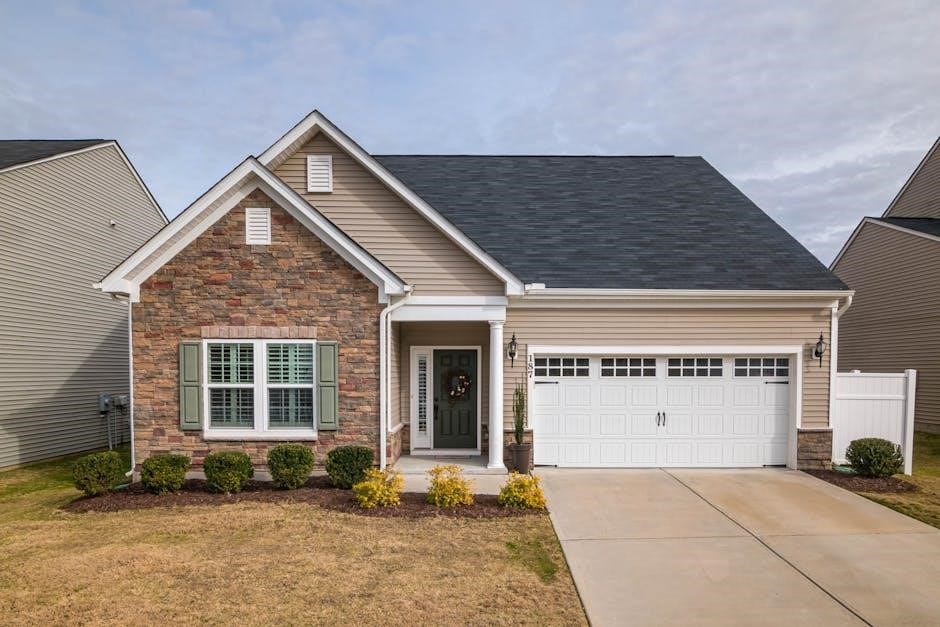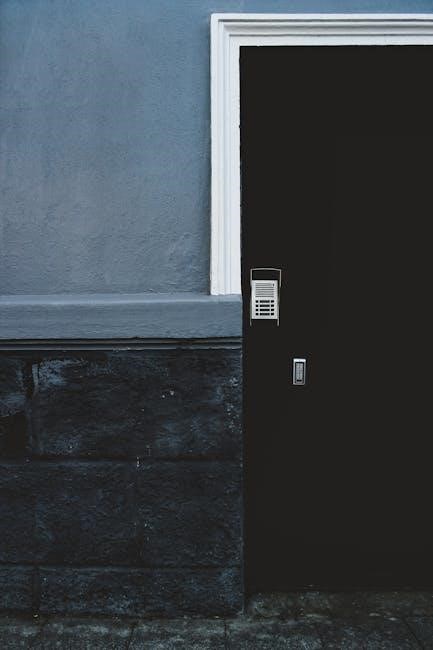Manually locking your garage door enhances security, especially during power outages or emergencies. It prevents unauthorized access and ensures your property remains safe. Learn effective methods to secure your garage door manually, offering peace of mind and protection for your belongings.
Importance of Manual Locking
Manual locking is crucial for enhancing garage security, especially during power outages or emergencies. It ensures your garage remains protected when automatic systems fail, offering an additional layer of protection. This method is cost-effective and provides peace of mind, safeguarding your property from potential breaches.
Common Scenarios for Manual Locking
Manual locking is essential during power outages, emergencies, or when increased security is needed. It ensures your garage door remains closed and secure, preventing unauthorized access. This method is particularly useful when automatic systems fail, providing an additional layer of protection for your property and belongings.

Assessing Garage Door Type
Assessing your garage door type is crucial for effective manual locking. Common styles include sectional, tilt-up, roll-up, and side-sliding doors, each requiring specific locking approaches.
Sectional Garage Doors
Sectional garage doors are the most common type, consisting of multiple panels connected by hinges. They typically feature horizontal tracks and can be manually locked using a sliding bolt or T-handle. For added security, a padlock can be attached to the track or a hasp installed at the door’s base. This ensures the door remains securely closed when locked.
Tilt-Up Garage Doors
Tilt-up garage doors open as a single panel, pivoting upward and outward. To lock them manually, install welding loops on the edges and secure with a padlock. Alternatively, use a C-clamp on the track above the roller to prevent movement. This provides a simple yet effective way to enhance security for tilt-up doors when manual locking is needed.
Roll-Up Garage Doors
Roll-up garage doors feature horizontal sections that coil above the opening. To manually lock them, install welding loops on both sides near the bottom and secure with a padlock. Alternatively, use a sliding bar lock that fits into the door’s track for added security. Ensure the door is fully closed before locking to prevent unauthorized access and enhance safety.
Side-Sliding Garage Doors
Side-sliding garage doors open horizontally, making them unique. For manual locking, install a hasp and padlock at the meeting point of the door sections. Additionally, using C-clamps on the track can prevent movement. Ensure the door is fully closed and aligned before securing it to maintain safety and prevent potential breaches in home security.

Manual Locking from the Inside
Manually locking your garage door from inside involves using sliding bolts or T-handles to secure it, providing an extra layer of safety beyond automatic systems.
Locating the Manual Lock
The manual lock is typically located near the internal release handle on your garage door opener. It appears as a small box with a lever or knob. Some doors feature a T-handle or sliding bar on the inside, while others may require installing a deadbolt or padlock for added security. Always ensure the lock is accessible and functional.
Disengaging the Automatic Opener
To manually lock your garage door, start by disengaging the automatic opener. Pull the emergency release cord, usually red, located on the door’s center rail. This disconnects the door from the opener, allowing manual operation. Once disconnected, the door can be closed and secured with a lock, ensuring it remains shut until you re-engage the opener.
Using a Sliding Bolt or T-Handle
A sliding bolt or T-handle provides a secure way to manually lock your garage door. Engage the bolt or handle to ensure the door cannot be opened from the outside. This method is effective for added security and works well in conjunction with other locking mechanisms, offering enhanced protection for your garage and its contents.
Securing with a Padlock
Adding a padlock enhances garage door security by providing an extra layer of protection. Install a hasp on the door where it meets the ground and secure it with a sturdy padlock. This simple solution deters intruders and ensures your garage remains locked, even during power outages or emergencies, offering reliable security for your belongings.

Manual Locking from the Outside
Securing your garage door externally adds an extra layer of safety. Use a hasp and padlock or weld loops for a reliable locking solution.
Installing a Hasp and Padlock
A hasp and padlock provide a secure external locking solution. Attach the hasp to the garage door where it meets the ground. Bolt it firmly and loop the padlock through the hasp. This prevents unauthorized access and adds an extra layer of security, ensuring your garage remains locked when needed.
Using Welding Loops
Welding loops offer a durable solution for manual locking. Install metal loops on both sides of the garage door, positioning them near the bottom and top edges. This allows you to thread a padlock through the loops, securing the door in place. The loops provide a robust locking point, enhancing overall garage security and preventing unauthorized access effectively.
Applying C-Clamps
C-clamps provide a quick and effective way to manually lock your garage door. Place the clamps on the door track above the rollers, tightening them securely to prevent the door from sliding open. This method is ideal for temporary security needs, such as during power outages, offering a reliable solution to keep your garage door locked when you need it most.

Using a Manual Locking Kit
A manual locking kit provides an extra layer of security for your garage door. It often includes a deadbolt or sliding bar lock, requiring manual operation for added safety and control.
Installing a Deadbolt Lock
A deadbolt lock offers robust security for your garage door. Start by marking the door and frame where the lock will be installed. Drill holes for the bolt and securing screws. Insert the deadbolt into the door and attach the strike plate to the frame. Tighten all screws firmly. Test the lock by sliding the bolt into place to ensure it secures the door properly.
A sliding bar lock is a simple yet effective way to secure your garage door manually. Attach the bar to the door and extend it across the opening. Secure it with brackets or hooks on the frame. Slide the bar into place and lock it with a padlock or built-in mechanism. This adds an extra layer of protection against unauthorized access. Manually locking your garage door involves disengaging the opener, closing the door fully, and engaging the lock mechanism. Ensure the door is secure by testing the lock after each step. To manually lock your garage door, start by disconnecting it from the automatic opener. Pull the emergency release cord, usually red, located near the center rail. This detaches the door from the opener, allowing manual operation. Ensure the door is fully closed before proceeding to the next steps for secure locking. This step is crucial for manual control. Closing the garage door is the first step in manual locking. Ensure it is completely shut and properly aligned with the frame. For automatic doors, press the opener button to close it. If manual, pull the door down until it latches securely. Proper alignment is crucial for effective locking and security; A misaligned door may not lock correctly, compromising its safety. Engage the lock by sliding the bolt or turning the handle into its locked position. Ensure it clicks securely into place for maximum stability and protection. Proper engagement ensures the garage door remains closed and prevents unauthorized access, enhancing overall security. Always verify the lock is fully engaged to avoid potential breaches. After engaging the lock, test it by gently pulling on the garage door to ensure it doesn’t budge. Verify the bolt or locking mechanism is fully secured and aligned properly. Check that no gaps remain and the door cannot be forced open. This step ensures the lock is functioning correctly and provides maximum security for your garage. Manual locking is essential during power outages, emergencies, or when extra security is needed. It ensures your garage remains secure and protected from unauthorized access. During power outages, automatic garage door openers often fail, leaving doors vulnerable. Manually locking ensures security and prevents unauthorized access. Use a padlock, hasp, or sliding bolt to secure the door. This simple step protects your belongings and maintains safety until power is restored. Always check alignment before locking for maximum effectiveness. In emergency situations, manually locking your garage door provides an extra layer of security. Use a hasp with a padlock or weld loops on the door edges to prevent forced entry. Ensure the door is fully closed and aligned before securing it. This quick solution offers peace of mind during critical moments, safeguarding your property effectively. Always test the lock after securing it. For heightened security, consider installing a deadbolt or sliding bar lock on your garage door. These manual locking mechanisms provide robust protection against break-ins. Ensure proper alignment and test the locks after installation. Regular maintenance and inspection of locks are essential to maintain their effectiveness and keep your garage secure. Always opt for durable materials for long-lasting security. For enhanced protection, install a deadbolt or bar lock on your garage door. Use C-clamps on tracks for temporary security and reinforce the door for added strength. A deadbolt provides robust security for your garage door. To install, align the bolt with the door frame and secure it with screws. Ensure proper alignment for smooth operation. This lock requires manual operation, offering an additional layer of protection and peace of mind. It’s a reliable solution for securing your garage effectively. Always test the lock after installation to ensure functionality. A bar lock is a popular and effective method for manually securing your garage door. Simply slide the bar into place across the door, ensuring it fits snugly into the track. This creates a strong barrier against unauthorized access. The bar lock is easy to install and use, offering an extra layer of security for your garage door. Reinforcing your garage door is a proactive step to enhance security. Install steel brackets or locking bars to strengthen the door’s resistance to forced entry. Additionally, using a deadbolt or sliding bolt lock can further secure the door. Regular maintenance and inspections ensure all locking mechanisms function properly, providing a robust defense against potential breaches. This creates a safer environment for your belongings. Identify and resolve issues like misaligned locks or stuck doors promptly. Check tracks, lubricate hinges, and ensure proper alignment for smooth operation. Regular maintenance prevents future problems. Misaligned locks can prevent the garage door from securing properly. Check if the lock bar or bolt aligns correctly with the receiving bracket. Adjust the lock mechanism or tracks if necessary. Ensure the door is closed fully and evenly. Lubricate hinges and rollers to maintain smooth operation. Regular maintenance helps prevent misalignment and ensures secure locking. If your garage door is stuck, ensure it is fully closed before attempting to lock. Apply lubricant to hinges and rollers to reduce friction. Check for debris or obstructions in the tracks. Gently maneuver the door to align properly with the frame. Regular maintenance can prevent sticking and ensure smooth operation when manually locking.Using a Sliding Bar Lock
Step-by-Step Process
Disengaging the Opener
Closing the Door
Engaging the Lock
Testing the Lock

Common Scenarios for Manual Locking
Power Outages
Emergency Situations
Increased Security Needs
Tips for Better Garage Security
Installing a Deadbolt
Using a Bar Lock
Reinforcing the Door

Troubleshooting Common Issues
Misaligned Locks
Stuck Doors